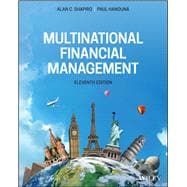The eleventh edition of Multinational Financial Management is a comprehensive survey of the essential areas of the international financial market environment, including foreign exchange and derivative markets, risk management, and international capital markets and portfolio investment. Designed for upper-level undergraduate and masters-level courses in international finance and management, this textbook offers readers a conceptual framework for analyzing key financial decisions of multinational firms. The authors both explain and simplify multinational financial management by illustrating how its basic principles share the same foundation as domestic corporate finance.
Assuming no prior knowledge of international economics or finance, this substantially revised new edition builds upon the fundamental principles of domestic financial management to examine the unique dimensions of international finance. Readers are presented with a solid theoretical knowledgebase for examining decision problems, as well as practical analytical techniques that clarify the often-ambiguous guidelines used by international financial executives. All the traditional areas of corporate finance are explored from the perspective of a multinational corporation, focusing on elements rarely encountered in domestic finance such as multiple currencies, segmented capital markets, and political risks of nationalization or expropriation.









